Weser-Renaissance Bremen, Manfred Cordes
60:15
cpo 555 216-2
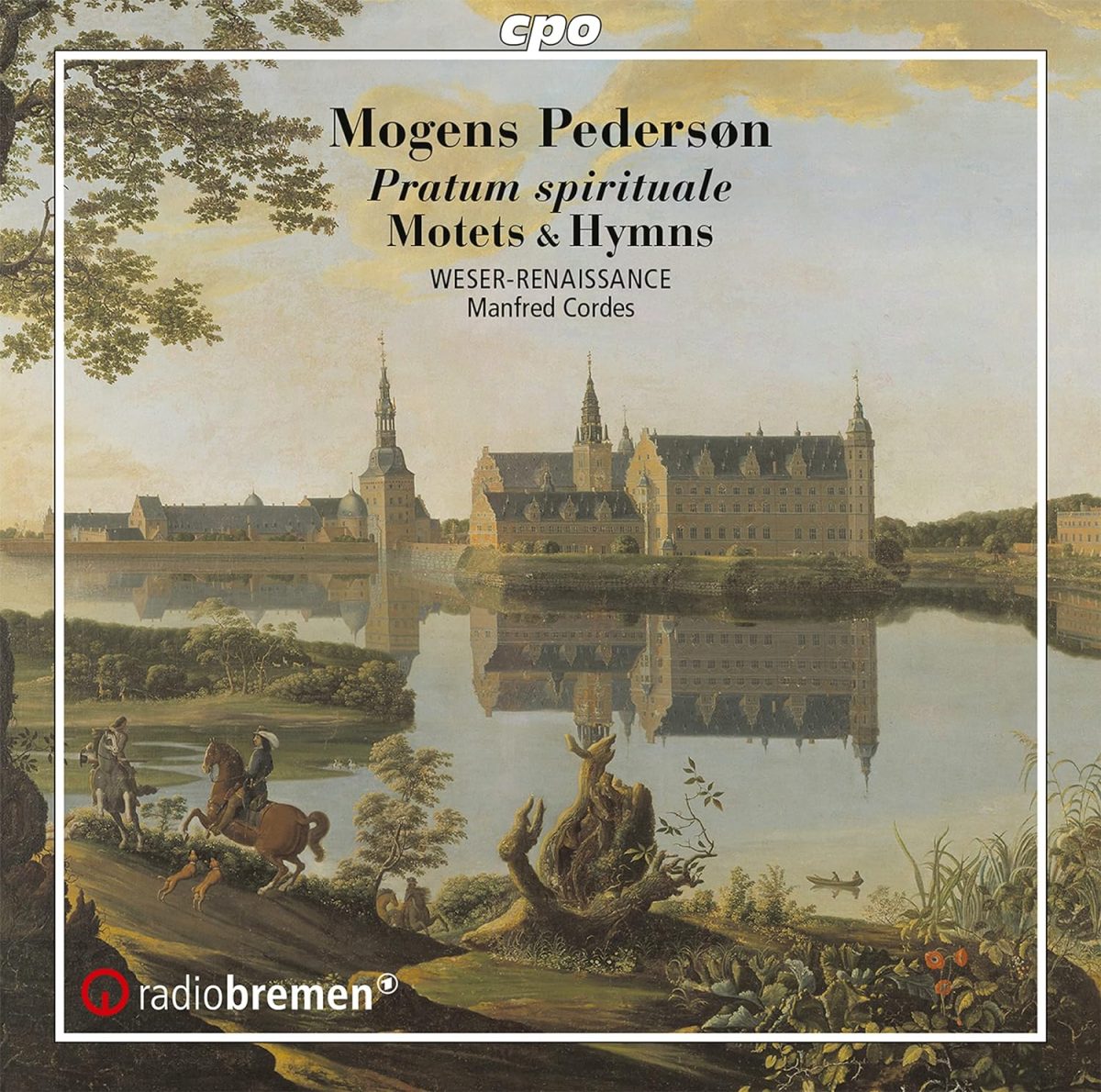
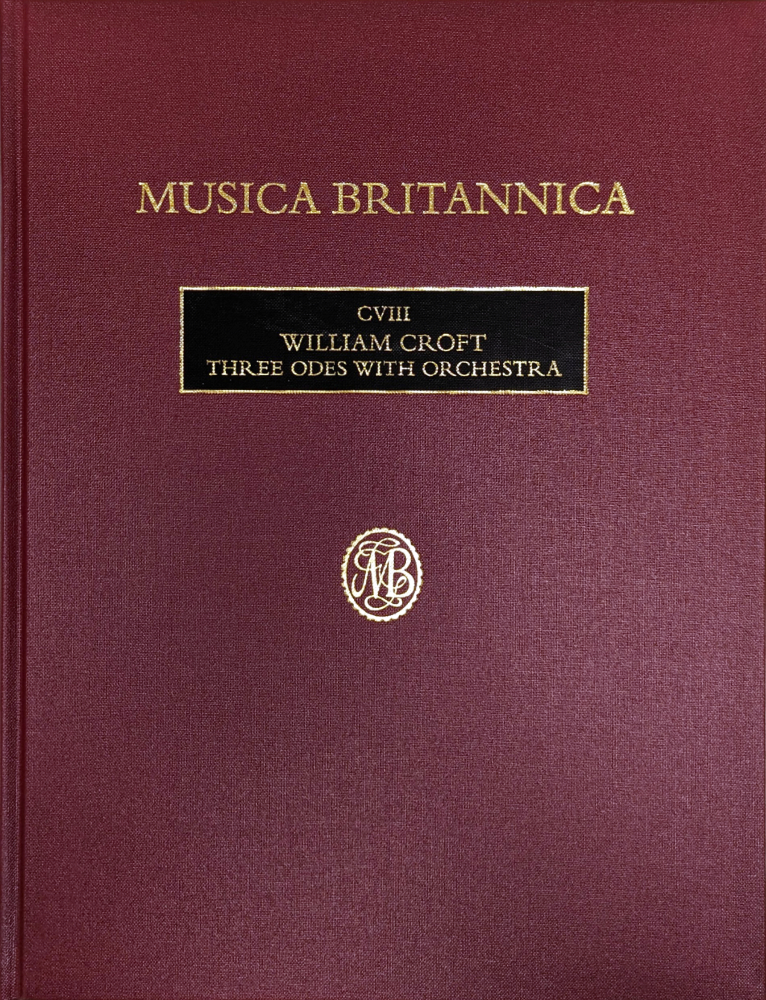
Edited by Alan Howard
Musica Britannica MB108
ISBN: 9780852499696 ISMN: 9790220228100
xlviii + 127pp, £115.00
Stainer & Bell
This excellent volume contains the two pieces Croft wrote to celebrate the Peace of Utrecht in 1713 – an earn his Oxford doctorate – and an ode (the editor Alan Howarth argues) to mark the Peace of Ryswick in 1697. if, as likely, that is the case, the composer would still have been a teenager, so the infelicities identified in the informative introduction might be forgiven. The main problem with the source (a later copy by one of Croft’s students from the 1720s) is the labelling of the instrumental parts – in the opening movement, there is a trumpet line (or two trumpet lines?) with unplayable notes, and the editor interprets the next four lines as violins where it strikes me as more likely that the first pair are oboes and the next pair violins. In the following movements, an alto is accompanied by recorders, the soprano and bass by strings, the bass by violins, and the full ensemble renders the short concluding chorus. The Utrecht pieces, whose performances in Oxford were noticed in the press, are far more substantial and it is clear that in the intervening years, Croft has matured as a composer. His debt to the Purcellian court ode is self-evident. Where we nowadays tend to think of him as being obscured by Handel, there is no sense in which this music is overshadowed by the German’s music for the Utrecht celebrations – indeed, some of his best choral writing might suggest that the influence worked in the opposite direction! I hope the availability of these fine pieces will inspire musicians to take up his cause – there really is a wealth of beautiful music here!
Brian Clark
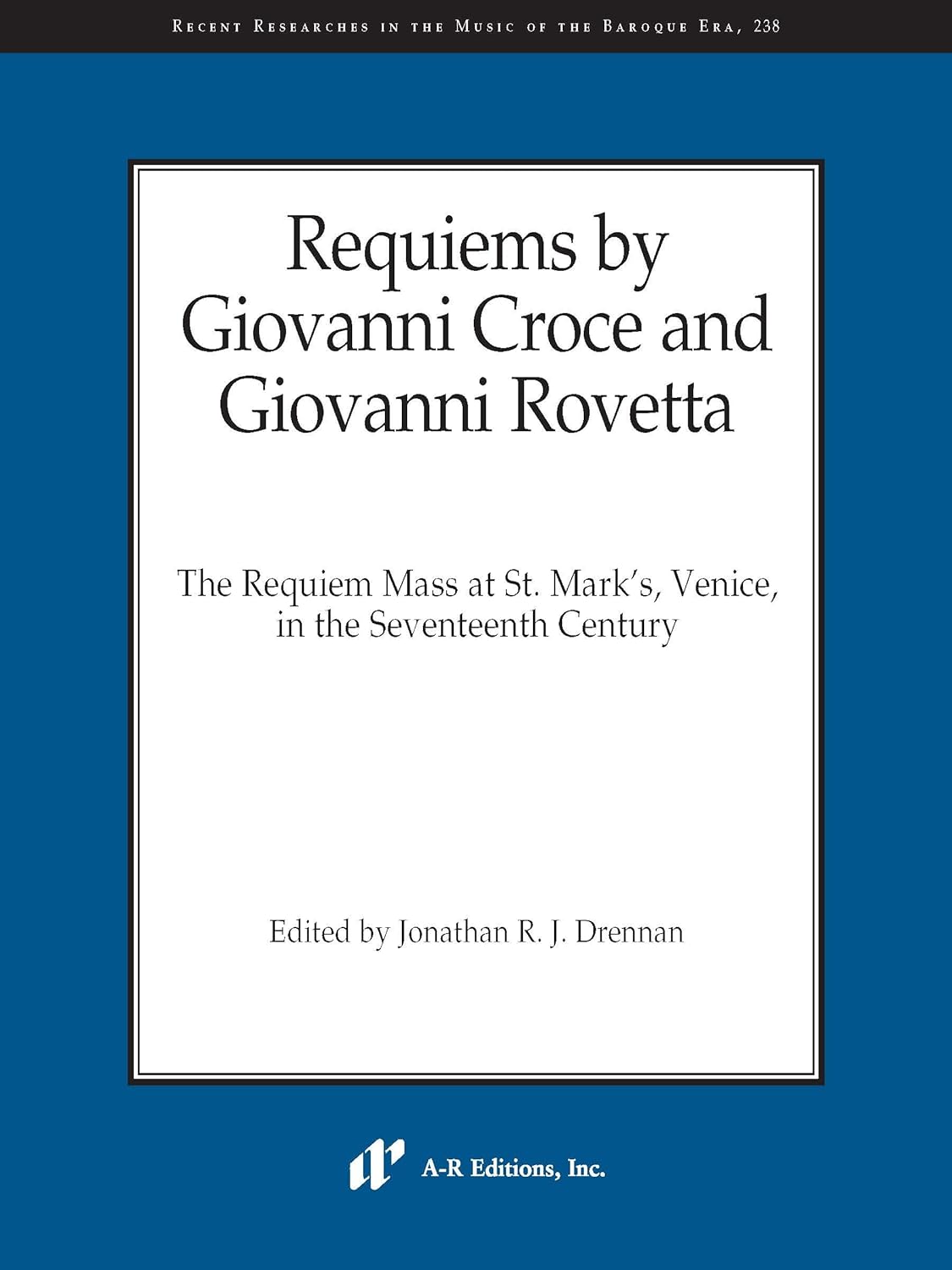
The Requiem Mass at St Mark’s, Venice, in the Seventeenth Century
Edited by Jonathan R. J. Drennan
Recent Researches in the Music of the Baroque Era, 238
xvii, six plates + 50pp $140
ISBN 978-1-9872-0865-8
This is the first of three volumes surveying Requiem settings at the basilica of San Marco from the 17th to the 19th centuries. After a detailed introduction, Drennan presents the two settings in the traditional A-R format, meaning that my usual gripes about wasted space and dumbing down of time signatures apply. Both works are written for ATTB choir and were intended to be sung from the bigonzo, a large raised “tub” (the edition includes two excellent photographs of the space); only Croce’s setting splits into two groups – and even then only for the Dies irae. Several pages could have been saved if, instead of printing eight staves every time one choir answered the other (on p. 21 meaning Choir 1 has ONE BAR at the end of the page), they were simply both presented on four staves and clearly labelled. This almost certainly have meant that the Sanctus and Agnus Dei would have appeared on an opening, rather than over two pages. Rovetta adds continuo to his setting but – again – space could have been saved (by printing the chant as a single line, for example!) and those two last movements would fit a spread. The music itself is written in the stile antico; polyphony is limited but both composers know how to use rhythm to keep their music interesting while fulfilling the necessity to declaim the text clearly. Both settings are extremely brief; Drennan suggests that has more to do with restrictions set by church authorities than the composers.
Brian Clark
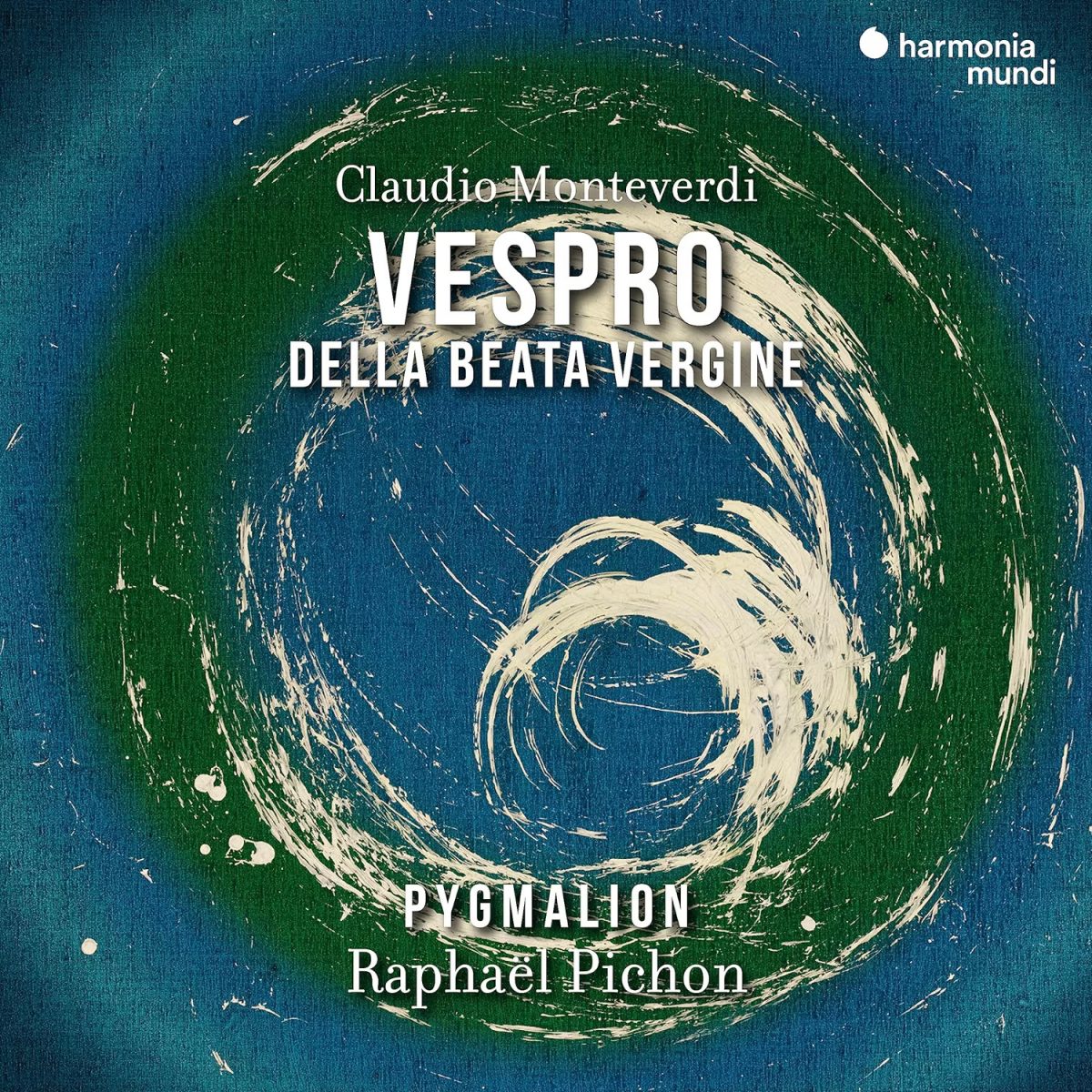
Pygmalion, Raphaël Pichon
102:00 (2 CDs in a cardboard box)
harmonia mundi HMM 902710.11
Raphael Pichon’s account of Monteverdi’s Vespers of 1610 has been through a process of metamorphosis since a rather unsatisfactory Proms performance in 2017 followed by a much more convincing account, filmed live in the Versailles chapel which I reviewed enthusiastically in 2019. This version still attempted to set Monteverdi’s music in something of a liturgical context, while unfortunately the DVD subtitles and support materials did a poor job in identifying the interleaved plainchant. This latest CD version for harmonia mundi accepts the current thinking that, far from being a discrete ‘piece’, the publication is a collection of Monteverdi’s best service music written for lavish celebrations of St Barbara at the Gonzaga court of Mantua and gathered together in a portfolio dedicated to the Pope in the hope of employment in one of the important papal institutions in Rome. The failure of this enterprise and Monteverdi’s subsequent career in Venice has frequently influenced performances of this extraordinary music, but actually the important point of reference ought to be the musically flamboyant court of Mantua. The practice of combining the sacred and secular musical resources for the most magnificent Mantuan services for St Barbara justifies the truly epic scale of Pichon’s presentation. It also obviates the need for a liturgical context, and even allows for the aesthetically satisfactory return to the opening fanfare set to relevant text to bookend the whole performance. Epic is the word that keeps coming to mind in describing this latest version of the Vespers, with over seventy musicians performing in the resonant acoustic of the Temple du Saint-Esprit in Paris. Pichon’s control over these large forces is breath-taking, and as previously his line-up of superlative soloists provides us with exquisitely decorated accounts of the solo and small ensemble material. Also prominent in these more intimate moments, although also adding magically to the tutti textures, is a superb team of continuo players, including two harpists, three theorbists, and three harpsichordists, one doubling organ. Their contribution is wonderfully imaginative and perfectly responsive to the voices. The brass and string sections, particularly the two double basses, provide an impressively rich texture to the tutti passages, while the four cornettists contribute virtuosic cadential embellishments which are simply stunning – just listen to them in the concluding doxology of Laetatus sum! Singing at ‘high’ pitch, Pygmalion’s chorus exudes energy and musical purpose and is a model of perfect phrasing and unanimity, while the harmonia mundi engineers have captured this whole remarkable sound in all its vividness. You can tell that this is a performance of a now familiar work which I found thrilling and engaging – it caused me to look back at my favourite accounts by Suzuki, Christophers, and Gardiner’s three versions, and further back to pioneering accounts in the early 1950s by Eugen Jochum and even Leopold Stokowski. What struck me is that for all their scholarly and stylistic shortcomings, the earliest versions had an epic sweep, which has sometimes been missing in later versions. It strikes me that Pichon has managed to embrace the scholarly and the epic dimensions of this music, while modern standards of recorded sound capture this in all its richness and subtlety. This version is not without its quirks – not everybody will like the rather ‘romantic’ dynamic variations (including the curiously ‘cowed’ opening of Dixit Dominus), while the decision to perform the opening and concluding verses of Ave maris stella a capella, when previous conductors’ instincts have been to combine the vocal and instrumental forces accrued in all the other verses, is a curious one. The fact is we have very little idea of the details of performance styles at the time, but knowing that opera singers joined forces with sacred musical forces for the larger-scale religious celebrations suggests that the inherent drama of the music might have been further enhanced for these courtly spectacles.
D. James Ross
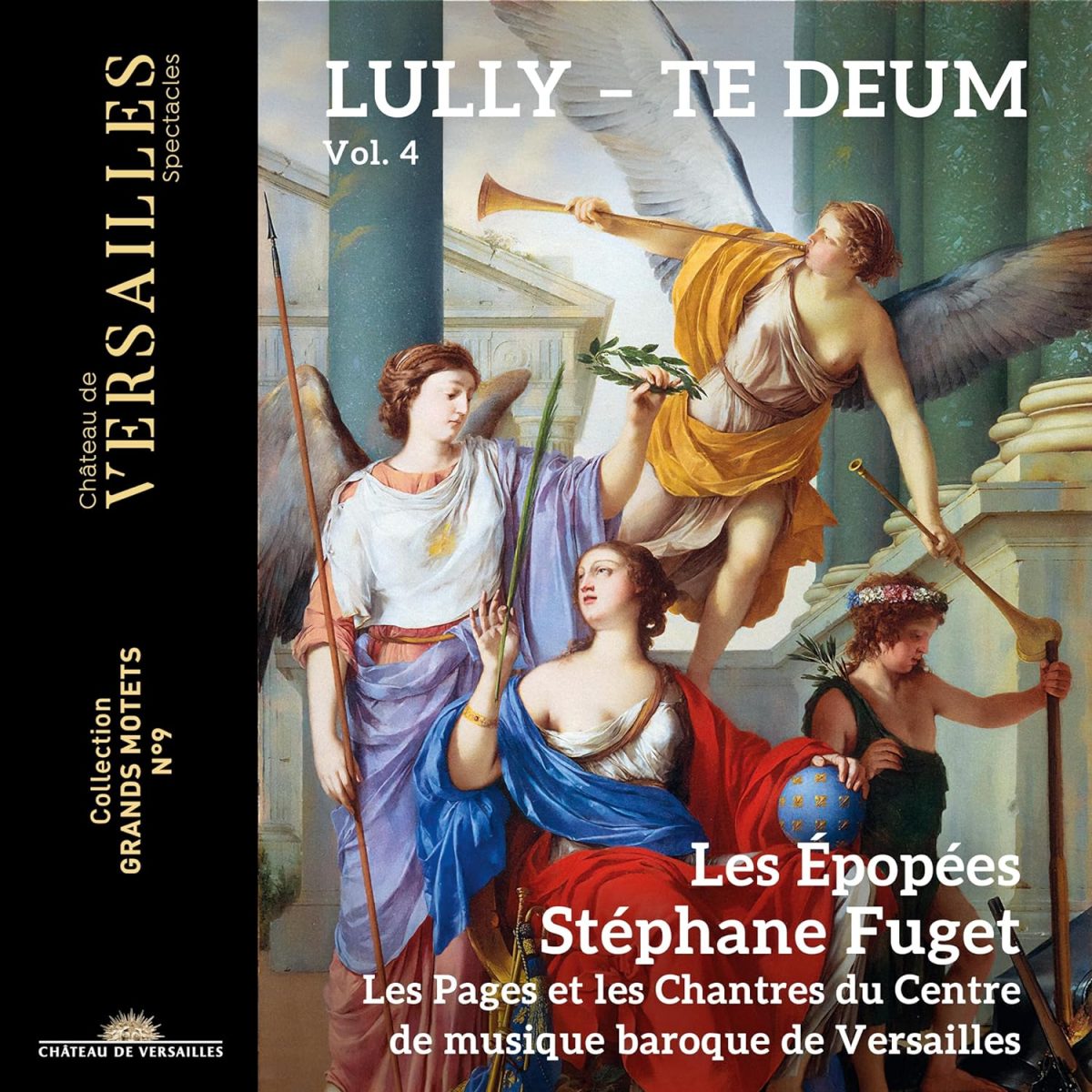
Les Épopées, Les Pages et les Chantres du Centre de musique baroque de Versailles, directed by Stéphane Fuget
68:24
Versailles Spectacles CVS117
This is the fourth in the indispensable series of Lully’s grands motets being undertaken by Stéphane Fuget and his vocal and orchestral ensemble Les Épopées, recorded in the glorious acoustic of the Chapelle Royale in the Palace of Versailles. Here, tackling the Te Deum of 1677 – perhaps the most brilliant and theatrical of all the motets – they are augmented by the forces of the Centre de musique baroque de Versailles to form an ensemble close to 100 strong.
The Te Deum was first given at Fontainebleau not to celebrate some great military victory, the usual reason for running up a Te Deum, as might be supposed but rather the more intimate occasion of the christening of Louis, the eldest son of Louis XIV (whom he predeceased) and Queen Marie-Thérèse. The king, who one suspects was more the target of its praise than the infant, was so delighted with it that he asked for it to be given again the following day. Thereafter it was repeated on several occasions, the last of which was in January 1687 when it was given to celebrate the king’s recovery following an operation. This was the famous occasion on which Lully injured his foot with the staff with which he beat time, an accident that resulted in his death from gangrene some weeks later.
The Te Deum is preceded, as it surely would have been on ceremonial occasions, by a pair of marches by the Philidor brothers, the first for timpani including a fascinating piece of syncopation. Perhaps the most striking aspect of the Te Deum is that, unlike so many occasional ceremonial works of its kind, it is far removed from being just a spectacular tub-thumper. Even in the most brilliant sections employing all the performers, the level of musical invention remains on an impressively high level, while many of the more intimate passages for the petit choeur or soloists have a calm, inner radiance. As so often with this genre, just as you think the ear is going to be overwhelmed by sheer splendour and brilliance along comes an ineffable, lyrical passage of heart-stopping beauty, here memorably realised. In common with most works in this genre, the key is thus contrast, contrast that spans the splendour of the opening and closing pages to the supplicatory verses from ‘Dignare, Domine’ (Vouchsafe, O Lord), beautifully sung here by an unidentified bass, through to the wonderful trio (two haute-contres and bass) into which the petit choeur steals almost imperceptibly.
The other motet included makes for an ideal companion piece given that it was apparently customary for Exaudiat te Dominus, Psalm 19 (20) to be performed after the Te Deum at major ceremonies, as it was indeed after the performance to give thanks for the king’s recovery mentioned above. Interestingly it is markedly different in style, a more succinct setting with more clearly defined sections and more solo passages. Less brilliant than the Te Deum, the trumpets and timpani are silent until the doxology, they are of course required to round off the coupling of the two works with a suitably flamboyant flourish .
The performances are electrifying in the more overtly ceremonial passages, at the same time achieving an interiority and prayerful grace in more intimate music. The involvement of all is underlined by remarkable diction, not easy in this building with its blessedly long reverberation, while the solo singing and that of the petit choeur is of exceptional quality as indeed is that of the full choir and orchestra. This is yet another quite exceptional and uplifting achievement from Stéphane Fuget and his exceptionally gifted forces.
Brian Robins
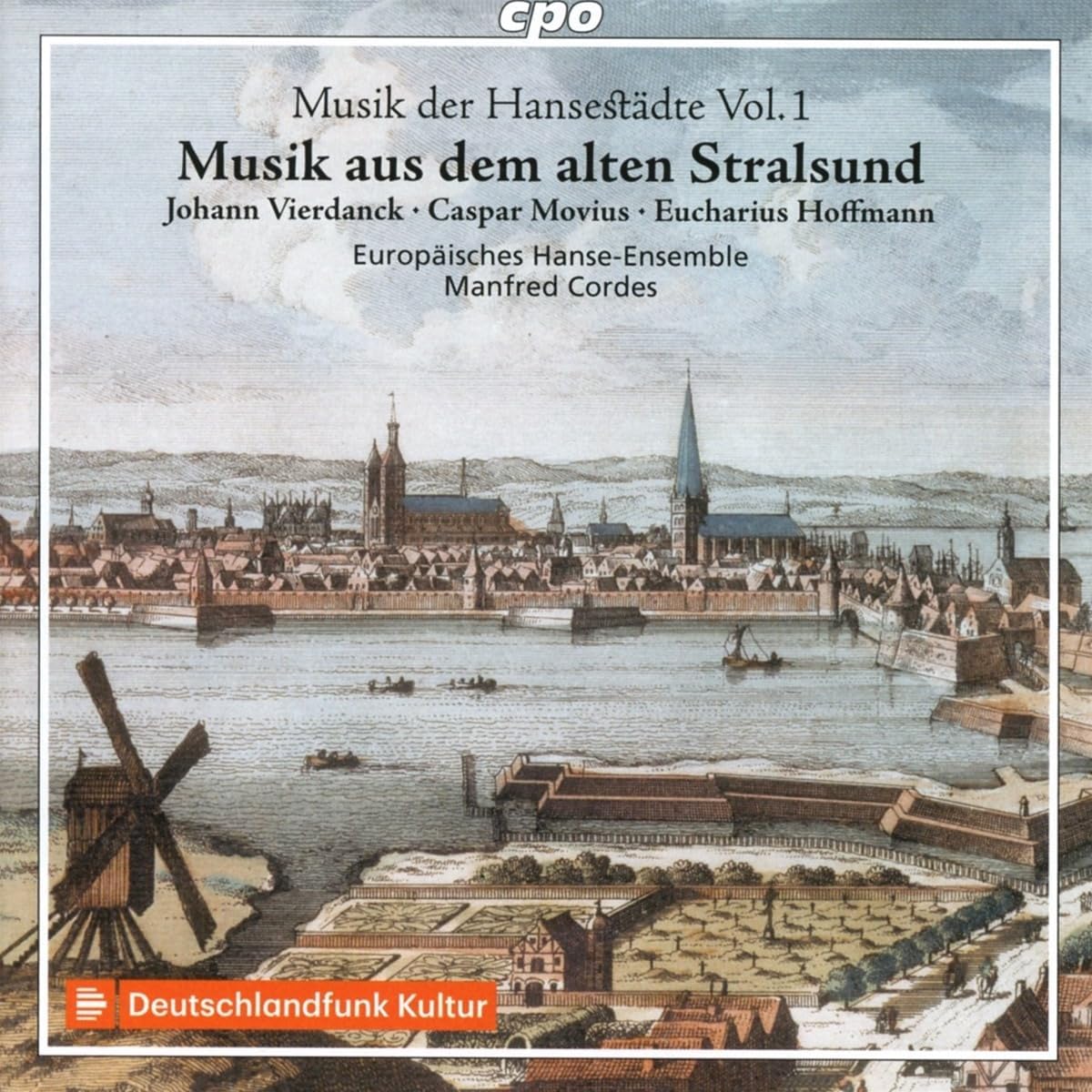
Musik der Hansestädte Vol. 1
Europäisches Hanse-Ensemble, Manfred Cordes
73:54
cpo 555 578-2
Like most of the cities that formed the Hanseatic League, Stralsund grew rich on the back of its trading activities. Much of the music on this disc (and the others that will join it in the series) will be at best little known; I had only heard of one of the three composers on the programme, Johann Vierdanck. Hitherto I had only known his instrumental music, though – through my studies of the musical life of the court of Anhalt-Zerbst – I was aware of his many publications of vocal music. Typical of Manfred Cordes, he has selected some truly wonderful music by him and by the even-less-well-known Caspar Movius (born five years after Vierdanck, he outlived him by 25!) and Eucharius Hoffmann, who was cantor at the city’s Latin School in the second half of the 16th century.
The disc is well balanced: four pieces by Vierdanck surround two by Movius, then four by Hoffmann (in a different style, as one would expect) then four more Vierdanck pieces frame another two by Movius. There are four instrumental pieces, all by Vierdanck; two sonatas a4 (one for pairs of violins and cornetti, one for cornetto and three trombones), a capriccio (two violins and gamba), and an extraordinary sonata a6 in D minor – I literally sat up straight when he had the instruments suddenly play in octaves! It was quite the unexpected effect. All of the vocal music is delightful, and beautifully sung. I am not surprised that the princes of Anhalt-Zerbst bought Vierdanck’s music for the local schoolboys to sing at weekly services. The first two Movius works are for double choir (sung one to a part here), while the second pair are for two sopranos and bass. Cordes deploys some instruments in three of the Hoffmann pieces, but the fourth is sung a cappella.
For anyone looking for an unexpected treat and a clear demonstration – if it were needed – that the 17th century in German music history does not just mean Schütz, Schein and Scheidt, this disc (and, indeed, many others curated by this innovative conductor), look no further! Buy this now.
Brian Clark
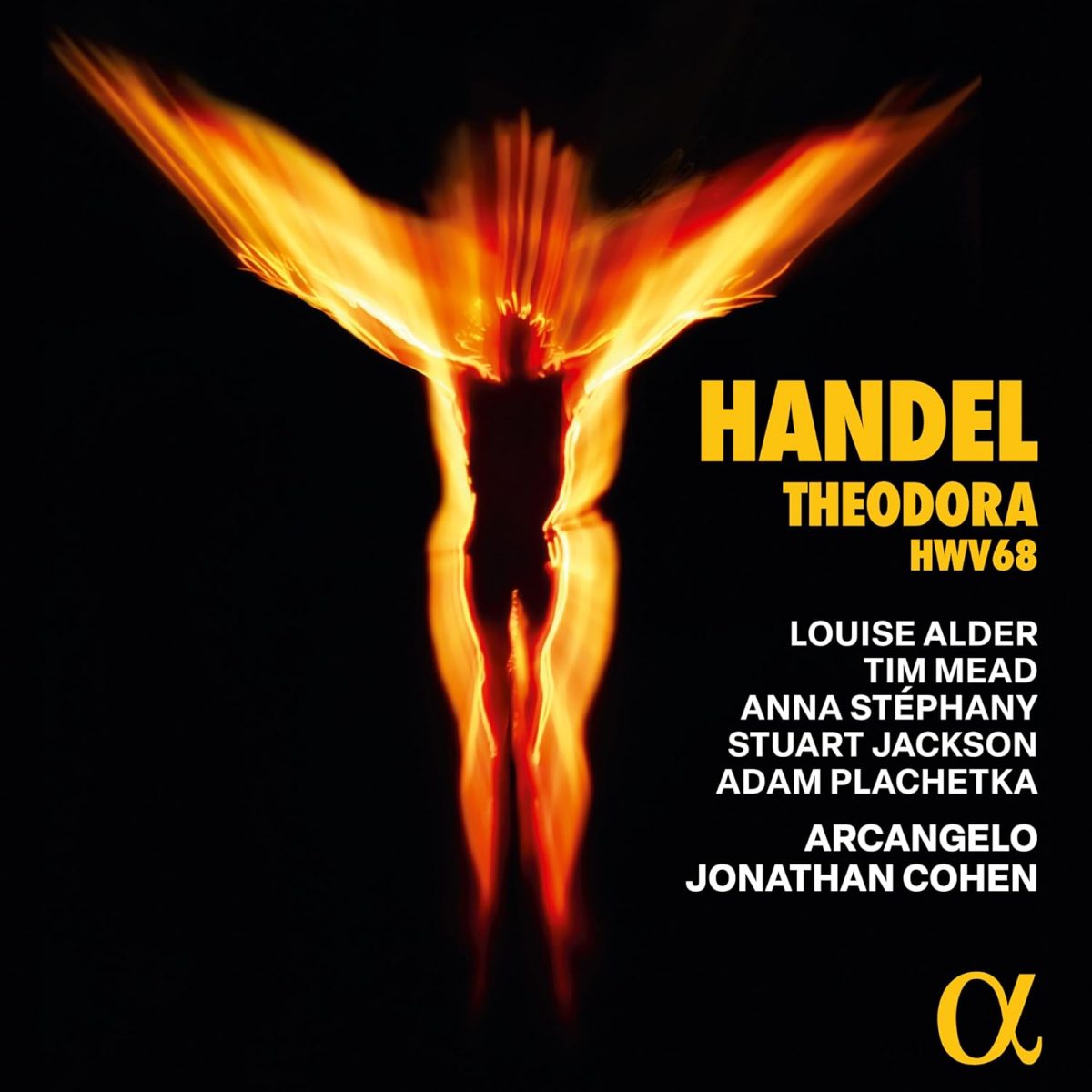
Louise Alder Theodora, Anna Stéphany Irene, Tim Mead Didymus, Stuart Jackson Septimus, Adam Plachetka Valens, Arcangelo, conducted by Jonathan Cohen
178:32 (3 CDs)
Alpha Classics ALPHA 1025
I concluded the review of the last recording of Handel’s Theodora I wrote for EMR with the words that it was a recording ‘to which I hope to return on many occasions’. It would be pleasing if it were possible to write something similar about this most recent issue but I fear it is not. Given that I provided an extensive background to Handel’s penultimate oratorio in that review, I’ll here just remind readers that it was first given at Covent Garden in 1750. It has a libretto of variable quality by Thomas Morell and was not generally liked by Handel’s audiences, although it became one of the composer’s favourite works. Today opinion tends to side with Handel. It has also become fashionable to stage Theodora, often controversially.
The Erato recording was a rare take on a Handel oratorio by an international cast (the Irene was Joyce DiDonato, who played the part in the recent Covent Garden staging) that shone new light on the oratorio by approaching it from a more dramatic, operatic viewpoint than we customarily hear in concert performances. Cohen’s recording takes us firmly back into mainstream oratorio territory as it is viewed currently. Overall it is a fair reflection of the state of early music performances in the UK since they fused with the mainstream. There are some good voices – that of Louse Alder’s Theodora in particular has a freshness and tonal quality that is especially appealing – but, with the exception of countertenor Tim Mead’s Didymus, all display continuous, often wide vibrato. There is little suggestion that any of the singers involved has a background or training much associated with Baroque repertoire, the articulation of passaggi frequently lacking clarity, while waiting for anything as exotic as a trill is akin to waiting for Godot, Mead again excepted. To be fair there are one or two embryonic attempts scattered through the performance, in at least one case coming from a singer whose vibrato is so wide it is difficult to tell what we are hearing. Diction is universally poor, ironically the best coming from the only non-native singer, the Czech bass-baritone Adam Plachetka, who sings the part of the Roman governor Valens with ripe relish.
Jonathan Cohen’s direction adopts tempos that veer to opposite extremes, those for excessively slower speeds often incorporating sentimental mannerisms. But for my ears the worst sin of all is that he fails to inspire those singing Christian sentiments, either soloists or choir, into expressing the kind of luminescent joy Handel so memorably conveyed in his music, where he captures the near-incandescent rapture and commensurate danger that the early Christians found in their faith. ‘New scenes of Joy come crowding on, while sorrow fleets away’, sings Irene as Theodora is led away to her death. Not here. Obviously given contemporary mores, the music of the heathen Romans with which Handel so brilliantly contrasts the Christian passages comes off more convincingly, particularly the orgiastic choruses. Finally, to return to practical considerations, Cohen has committed the cardinal sin of not just including a superfluous lute in the continuo, but allowing it to be unforgivably obtrusive.
I’ve probably been unduly harsh on this performance. Listeners and critics inclined to mainstream performance will almost certainly value it more; indeed I’ve seen notices that overrate it to a grotesque degree. But I’m here writing for a readership presumably interested in HIP performance and from a personal viewpoint that the recording sadly mirrors the current poor state of early music in the UK. Fortunately there is always McCreesh’s superlative Archiv recording to which we can return, while the Erato makes for an interesting variant.
Brian Robins
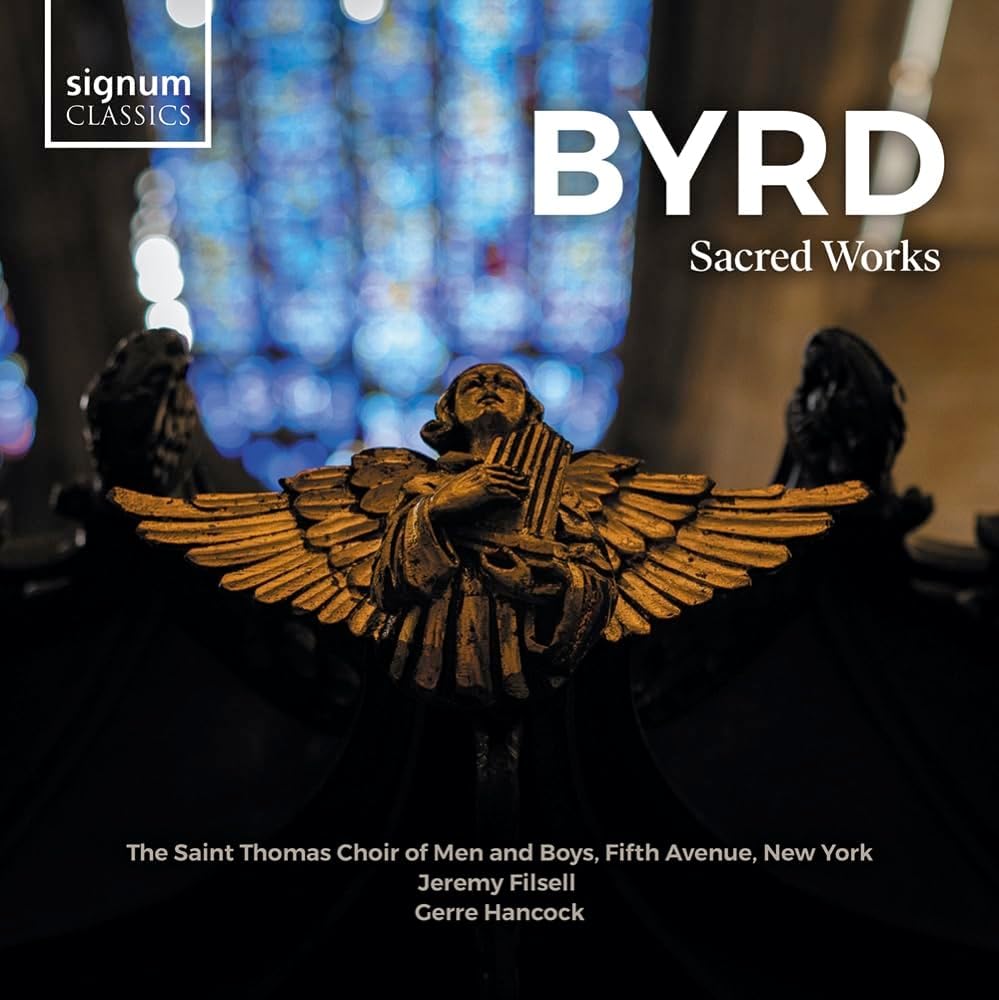
The Saint Thomas Choir of Men and Boys, Fifth Avenue, New York, conducted by Jeremy Filsell (2022) with Nicholas Haigh, Assistant Organist; and Gerre Hancock (1981)
Recorded in St Paul the Apostle, Columbus Circle, New York (2022) and St Mary the Virgin, Times Square, New York (1981)
Mass for Four Voices, Propers for Corpus Christi (2022),
The Great Service (1981)
1441:01 (2 CDs)
Signum Classics SIGCD776
This double album has a bland title, “Sacred Works” but … what wonderful works. We cannot have too many recordings of music this good, and when it is performed as well as it is here, we are all winners. After 2023 marked Byrd’s successful, enjoyable and rewarding Quatercentenary, 2024 is the centenary of the rediscovery of Byrd’s Great Service in Durham Cathedral, by his indefatigable cheerleader E.H. Fellowes, and of its first performance in (probably) three centuries, which took place in St Margaret’s Church, Westminster sung by the Newcastle upon Tyne Bach Choir under W.G. Whittaker, himself no mean Byrd scholar. So it is excellent to welcome back into the catalogue St Thomas Choir’s recording of the complete work made in 1981 and hitherto only available as an LP. What sounds as if it might be intrusive traffic noise from Times Square, outside the recording venue, can be heard but this is a small price to pay for the privilege of having access to this stunning performance. (Credit to the engineers who made the transfer from the original LP, a copy of which I used to own.) Of five other available complete recordings, only two are by Anglican church choirs – King’s College, Cambridge, and Westminster Abbey – and neither of those are, like St Thomas New York, unaccompanied. So this is also a unique recording. The performers set out their stall right from the opening verse passage of the Venite, the first canticle in the Service; this is delivered with crystal clarity, the fleeting dissonance on “strength” distinctly audible in the generous acoustic. The recording was made just too soon to take advantage of Craig Monson’s imminent edition (1982) with its new thinking as regards certain verse and antiphonal passages, but there is still some variety between the verse, antiphonal and full passages as laid down in Fellowes’ edition (1948).
Modern trends in Byrd scholarship also impinge upon the rest of the album, the disc and a half recorded over forty years later, which feature the Mass for Four Voices and Propers for Corpus Christi. And these are proper Propers, as they include not only those items for the Feast which are in book one of Gradualia (1605) but also Byrd’s expansive unpublished setting of Sacris solemniis – all nine and a half minutes of it – composed while he was still influenced by Sheppard, whose mentorship of the fledgling Byrd is unfailingly neglected in favour of Tallis. Current scholarly thinking advocates performances of Byrd’s masses by small mixed ensembles, resembling those documented as performing such music in secret recusant chapels during the reign of Queen Elizabeth I, ironically a closet Anglo-Catholic … allegedly. Nevertheless, these masses have now become staples of choral Holy Communion in (protestant) Church of England cathedrals, churches and chapels, as well as in similar Roman Catholic establishments. Also, they are so well composed as to sound as fine in great spaces as in small. The Choir of Saint Thomas Church, New York sings the mass with as much beauty, feeling and expertise as any historically informed ensemble, and I say this as one who favours authenticity so far as it can be achieved in early music. The generously reverberant acoustic takes some getting used to, but once the ears are, so to speak, tuned in, the sound becomes quite ravishing, and although tempi are varied judiciously during the course of the Mass, this is never to the detriment of the clarity of Byrd’s eloquent polyphony, with its sublime melodies, harmonies … and dissonances! In each of his works, Byrd relates a narrative. In liturgical performances, tempi can be varied, subtly or otherwise, but usually in response to musical criteria, such as Classical or Romantic models, or in a perceived need to push on or put the brakes on. St Thomas’s interpretation seems rather to respond to Byrd’s narrative, his response to the text and his inflections in his music that propel his vision. Jeremy Filsell’s subtle pacing does not routinely include sudden bolts after passages of restraint: for instance, in the Credo it is appropriate to show some animation at “Et resurrexit” but he keeps the Choir’s powder drier at the equally tempting “Et unam sanctam” which then allows the singers to wind up over a longer span towards an effective climactic conclusion. Also in the Credo is one of the most sublime passages of singing that I have ever heard in a Byrd Mass on disc, where the layclerks alone sing “et ex patre natum ante omnia saecula”. That said, I must also compliment the boys on their fine singing throughout the entire work, not least those trebles entrusted with the solo passages. A word of congratulation also to the Rector, Revd Canon Carl F. Taylor, who fulfils his roles as Celebrant and Gospeller consummately.
This is a truly radiant recording. As I said of another recent Byrd release, whatever the number of versions you possess of the Mass for Four Voices – many, few, one, none – do, please, give serious thought to purchasing this one … and then buy it! It comes with two priceless bonuses: Byrd’s incandescent Propers for Corpus Christi including that early unpublished setting of Sacris solemniis with its echoes of Sheppard, not Tallis, and its pre-echoes of the treasures to come in Byrd’s music; plus the greatest of all settings of the complete Anglican Service, sung by a Choir as fine in 1981 as it would still be four decades later.
Richard Turbet
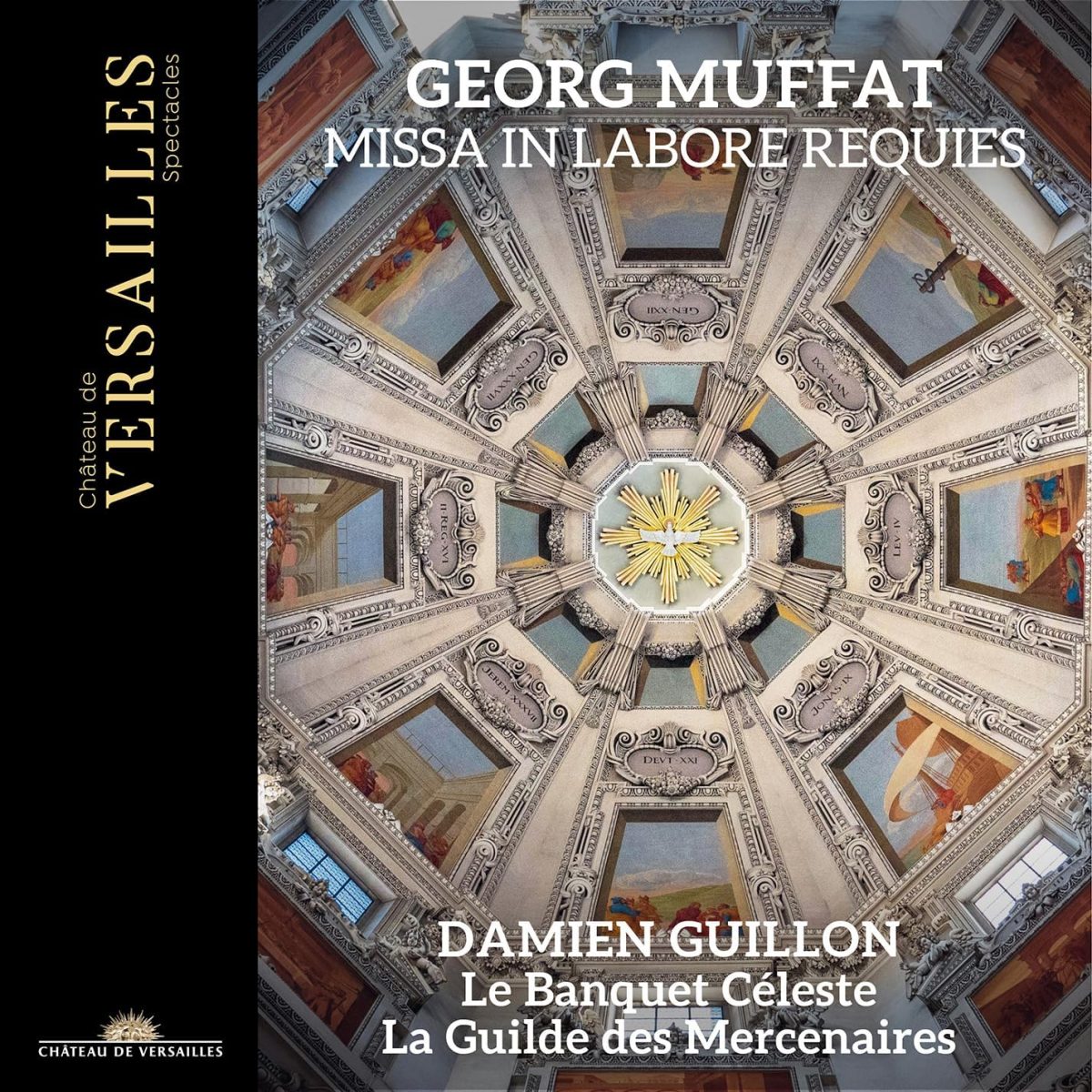
Le Banquet Céleste, La Guilde des Mercenaires conducted by Damien Guillon
58:53
Versailles Spectacles CVS106
It would be hard to find a better example of the current strength of early music in France than this splendid collaboration between two ensembles based not in a major population centre but in the provinces. One, the vocal ensemble Le Banquet Céleste, is likely to be familiar to anyone who follows the early music scene, but La Guilde de Mercenaires, fundamentally a wind and brass ensemble and like Le Banquet based in Brittany may be a less well-known name. In a note Damien Guillon tells of how their mutual ambition to perform and record Georg Muffat’s monumental 24-part Missa in labore requies (‘rest in our toil’), words taken from the medieval sequence, Veni Sancte spiritus) came to be realised in the superb acoustic of the Chapelle Royale at Versailles.
Muffat’s Mass is one of a number of such works composed for Salzburg Cathedral as part of the Counter-Reformation assault on the senses, the creation of brilliantly theatrical liturgy. Salzburg Cathedral, with its separate galleries, offered an ideal venue (there is a strong temptation to say stage) in which to exploit the polychoral tradition that had developed in Venice in the 16th century. Such works required the disposition of both vocal and instrumental choirs distributed in the various galleries. The most famous of such works is, of course, the so-called Missa Salisburgensis, once attributed to the Italian composer Orazio Benevoli (1605-1672), but now firmly established as the work of Biber.
The Muffat has a strange history, having come down to us in an autograph score in Joseph Haydn’s estate. Even more oddly given its celebratory character no specific occasion is known to have inspired its composition, though Peter Wollny’s note is in little doubt that it was composed for Salzburg. However, the note by Ernst Hintermeier for the earlier harmonia mundi recording directed by Konrad Junghänel, postulates that it may have been composed for the induction of a new archbishop at the court at Passau in 1690, the year Muffat left Salzburg to become Kapellmeister there. The disposition of the Mass calls for two SATB vocal choirs, here with two voices each, plus three instrumental choirs, one of strings and the other two for wind and brass. A small continuo group completes the forces, which throughout are deployed in a dazzling array of combinations ranging from sumptuous passages for the full ensemble to passages of chamber-like finesse and interiority. As so often in large-scale works it is unexpectedly these moments of intimacy that tend to remain longer in the memory than the more overtly spectacular passages, impressive though those are. But the work as a whole seems to me richer in imagination and invention than the works of Biber of this kind with which I’m familiar. There are so many examples that it is difficult to single out individual moments. ’Laudamus te’ from the Gloria may however be one such, an exuberantly florid display of solo voices led by the soprano of Choir I over running bass, the whole creating a kind of perpetuum mobile. Shortly after that the dense fugal tapestry of ‘Qui tollis’ creates a passage of wonderful penitential breadth. Often the passages one expects to be highlighted are especially memorable. The crucial central part of the Credo, for example, is a sublime setting of ‘Et incarnatus est’ for two sopranos, while the ‘Crucifixus’ is a polyphonic solo SATB quartet accompanied by only organ continuo. Here the muffled drumbeats at the mention of Jesus’s death remind us of the essential theatricality of the music. The opening of the Agnus Dei inspires another exquisitely contemplative soprano solo before building to an impressive climax at ‘Dona nobis’. The Credo and Sanctus are punctuated by a Dixit Dominus from Biber’s Vesperae Longiores ac Breviores , the brevity and comparative simplicity the answer to the command for such discipline from freshly installed Salzburg Archbishop Ernst von Thun. Mozart it seems was not the only one to be hampered by such edicts in Salzburg!
The performance of the Muffat is on the highest level throughout both as to the vocal and instrumental contributions. I’ve mentioned the soprano soloists several times during the course of this review and Violaine Le Chenadec (choir I) and Myriam Arbouz (choir II) certainly deserve special mention, but it is to the credit of Damien Guillon that the whole performance deserves the highest possible praise. The same goes for the engineers who have gloriously wrapped the performance in the distinctive acoustic of the Chapelle Royale. It’s a performance I would tend to prefer to the fine but more objective Junghänel.
Brian Robins
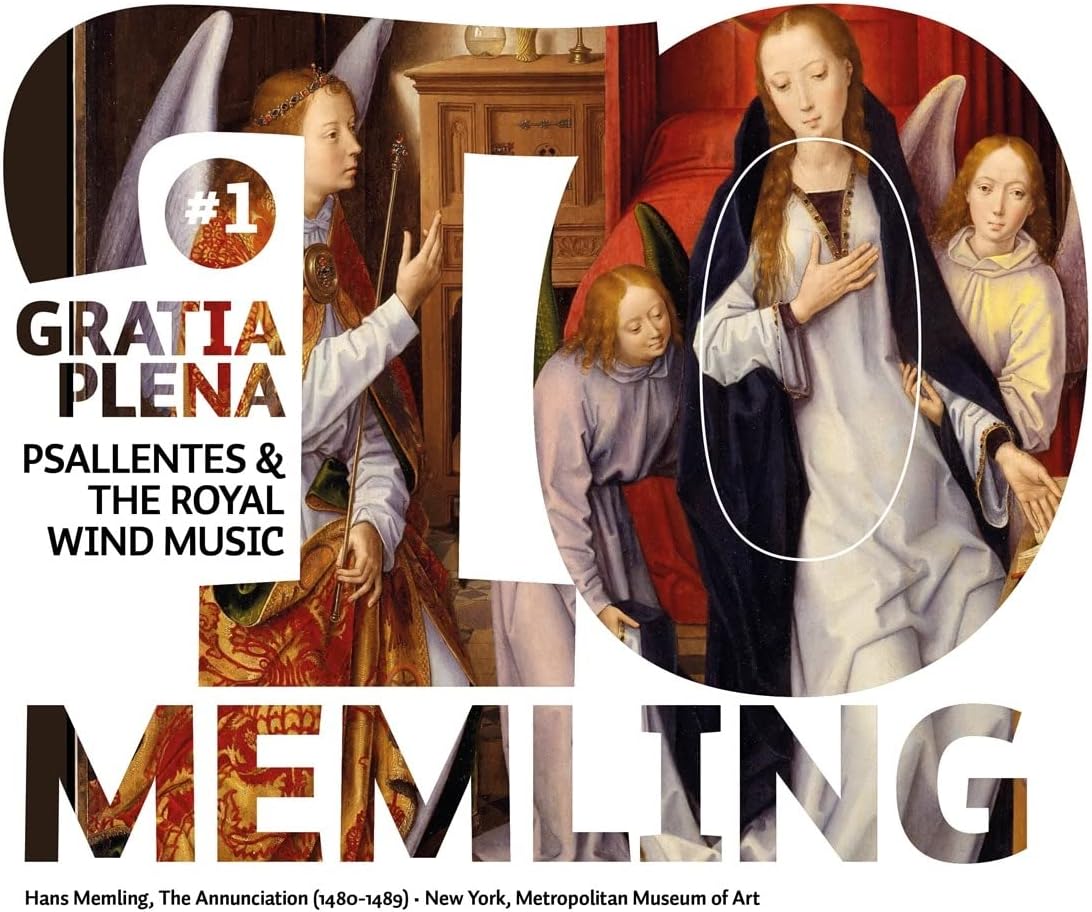
Psallentes, The Royal Wind Music, Hendrik Vanden Abeele
71:04
Le Bricoleur LBCD 14
Unusual to have one CD based on a famous old master painting, but along with The Sword and the Lilly, a meditation on van der Weyden’s ‘The Last Judgement’ (Inventa INV 1008), we have another musing, this time on ‘The Annunciation’ by Hans Memling. His exquisitely detailed rendition of angelic musicians has allowed instrument builders to reconstruct instruments which have not survived in any other form, so he is an obvious inspiration for a CD programme. Like the Inventa CD, this CD programmes music relevant to the subject and details of the painting, assembling polyphony by de Ghizeghem, Agricola, Obrecht, Dufay, Compère, Mouton and Josquin played on recorders by The Royal Wind Band and sung by Psallentes, who also provide plainchant. The performances from these splendid Flemish ensembles are, like Memling’s painting, exquisitely detailed and wonderfully evocative. The sounds conjured up by consorts of beautifully tuned and blended Renaissance recorders are a delight, as are the female voices of Psallentes, also beautifully pure and focussed. My favourite tracks are where the voices and recorders combine in the larger-scale polyphony and culminating in a stunning account of the Gloria from the famously demanding Missa Maria zart by Obrecht, given a delightfully transparent performance here. With the imaginative blending of voices and recorders and the sheer musicality of these accounts, I was more persuaded by this painting-based musing, although the rather shallow supporting booklet in which Vanden Abeele writes a ‘Dear Hans’ letter to Memling and offers Gratias agimus tibi to him for the CD’s artwork rather trivialises this excellent project. I am on record elsewhere opining that a serious scholarship-based musical programme, such as this most definitely is, deserves a seriously scholarly programme note rather than some self-indulgent performer’s flight of fancy.
D. James Ross